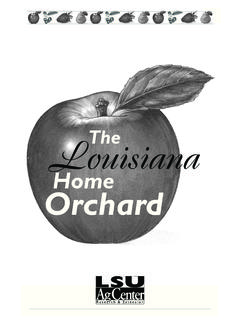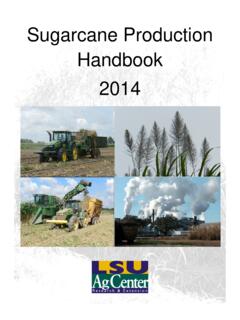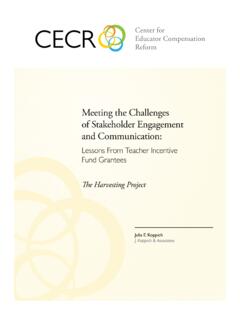Transcription of Home Orchard - LSU AgCenter
1 The Louisiana home Orchard .. Louisiana The Louisiana home fruit production appeals to many urban homeowners with limited space as well as to rural residents. home -grown vine or home tree-ripened fruit is higher in quality than that Orchard bought at the grocery store. Growing your own fruit can be profitable and satisfying, and most fruit trees add to your landscape. You cannot expect to grow quality fruit without caring for the plants. Success will depend largely on variety selection, soil management, pruning, fertilization, irriga- tion, pest control and other cultural practices.
2 The size of your planting should be determined by the space available, site, size of your family and the time you can devote to Orchard maintenance. Select a Good Location The success of the home fruit planting is influenced greatly by the site selected. This cannot be overemphasized. Remember: cold air, like water, flows downhill, so avoid low frost pockets. A deep, well-drained soil with good surface and subsurface drainage is important. Fruit plants will not grow well in water-logged soil. Also, the site should provide ample sunlight for proper growth and development of the plants.
3 Choose the Right Kind of Fruit The decision to plant fruit should involve careful variety selection. Not all fruit species are adapted to all areas of Louisiana. To plant a given type or variety without considering its adaptation can lead to disappointment. We are often led to believe that many of the older, well-publicized varieties will do well in Louisiana home gardens. For example, the Bartlett pear and Elberta peach are two fruit varieties that have little place in a Louisiana fruit planting. The Elberta peach has been replaced by superior peach varieties, and the Bartlett pear is not adapted to our climate.
4 Many factors ultimately determine the adaptation of a given fruit species to an area. Some of these conditions are discussed here. Chilling Requirement Most fruit species not of the tropical type have a rest period. This is a stage of plant inactivity commonly associated with a loss of leaves or dormancy in winter. Such plants will remain in this rest period until they receive a specific number of hours of cold below typically 45 degrees F. This is referred to as a chilling require- ment. The chilling requirement of a given variety of fruit is genetically controlled and is constant for that variety.
5 When the rest period is satisfied, the plant awakens and becomes active with the warmth of spring. Some varieties may have rest periods of only 200 to 300 hours; others may have more than 1,000 hours. Pineapple pear, for example, because of its short rest period, will normally bloom with the first warm . period of spring, often being injured by late cold weather. Other varieties with longer rest periods do not bloom until a month or so later. A plant that does not receive sufficient cold to satisfy its rest period requirements does not perform well. They are often delayed in both leafing out and blooming and will have a scattered bloom over a long period or blossoms may drop.
6 In extreme cas- es, unadapted plants will not live more than a season or two in areas of warm winter. Insect and Disease Resistance Most homeowners are not adequately equipped to spray for control of insects and diseases. This problem can be minimized by selecting fruit types with few pest prob- lems or selecting varieties with resistance to known pests. Fruit species may be grouped as high, medium or low maintenance crops relative to pest control needs: Low Medium High Maintenance Maintenance Maintenance Fruit Types Citrus Muscadine Grape Apple Blueberry Blackberry Peach & Nectarine Fig Plum Persimmon Strawberry Loquat Bunch Grapes Pears (some varieties) Mayhaw It is wise to select fruit types primarily from the low-maintenance category.
7 Fruit,Variety, Area and Fertilizer Recommendations Remarks (Fertilizer should not Fruit Variety Area Spacing be placed within 9 of plant.). Apple Ozark Gold N 20'x25'. Golden Delicious N 20'x25'. Red Delicious N 20'x25' Fertilize at 1 lb. 8-8-8/yr/tree age. Stayman Winesap N 20'x25' Do not exceed 5 lbs per tree. Granny Smith N 20'x25'. Gala N 20'x25' Anna needs pollinizer. Dorset Molly Delicious N&S 20'x25' Gold pollinates Anna. Anna S 20'x25'. Dorset Gold S 20'x25'. Blueberry Tifblue N&S 6'x8' Apply fertilizer at 2 oz. 8-8-8/yr/. Powder Blue N&S 6'x8' tree age in February and after Climax N&S 6'x8' harvest.
8 Do not exceed 1 1/2. Premier N&S 6'x8' lb/plant. Comparable rates of camellia/azalea fertilizer can be Brightwell N&S 6'x8' used. Ochlockonee N&S 6'x8' Ochlockonee and Alapaha are Alapaha N&S 6'x8' trial only, new. Brambles Boysenberry N&S 4'x6'. Trailing Type Youngberry N&S 4'x6'. Brison S 3'x6'. Womack N&S 3'x6' Apply fertilizer at 1/2 lb 8-8-8/yr/. Brazos N&S 3'x6' tree age/10 ft of row in February Semi-erect Type and after harvest. Don't exceed Cheyenne N&S 3'x6'. 2 lbs/ft/row. Apply in 3 ft. wide Shawnee N&S 3'x6'. band. Roseborough N&S 3'x6'. Kiowa N&S 3'x6' Navaho and Ouachita late Navaho (thornless) N 2'x6' ripening.
9 Arapaho early ripening. Erect Type Arapaho (thornless) N&S 2'x6'. Apache (thornless) N 2'x6'. Ouachita (thornless) N&S 2x6. Raspberries Dorman Red N&S 4'x6'. Citrus Armstrong Early S 15'x30'. Owari S 15'x30'. Louisiana Early S 15'x30' Fertilize at 1 1/2 lbs. 8-8-8/yr/tree Satsuma age up to 12 yrs. Do not exceed Kimbrough S 15'x30' 15 lbs per tree in February. Early St Anne S 15'x30'. Brown's Select S 15'x30'.. Remarks (Fertilizer should not Fruit Variety Area Spacing be placed within 9 of plant.). Citrus (continued). Hamlin Sweet S 15'x30'. Louisiana Sweet S 15'x30'. Ambersweet S 15'x30'.
10 Sweet Orange Moro Blood S 15'x30'. Plaquemines S 15'x30'. Pineapple Sweet S 15'x30'. Valencia S 15'x30'. Navel Washington S 15'x25' Apply fertilizer at 1 1/2 lb. Duncan S 15'x30' 8-8-8 age in late January- Grapefruit Rio Red S 15'x30' early February. Do not exceed Ruby Red S 15'x30' 18 lbs. per tree. Tangelo Orlando S 15'x25'. Mandarin Ponkan S 15'x25' Kumquat is a sweet variety. Lemon Meyer S 15'x25'. Dancy S 15'x25'. Robinson S 15'x25'. Tangerine Sunburst S 15'x25'. Orlando S 15'x25'. Nagami S 10'x15'. Kumquat Meiwa S 10'x15'. Fig LSU Purple N&S 15'x25'. LSU Gold N&S 15'x25'. Celeste N&S 15'x20'.
















